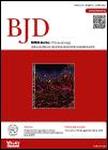版权所有:内蒙古大学图书馆 技术提供:维普资讯• 智图
内蒙古自治区呼和浩特市赛罕区大学西街235号 邮编: 010021

作者机构:Univ Pittsburgh Sch Med Dept Dermatol Pittsburgh PA 15213 USA
出 版 物:《BRITISH JOURNAL OF DERMATOLOGY》 (英国皮肤病学杂志)
年 卷 期:2010年第163卷第5期
页 面:1090-1094页
核心收录:
学科分类:1002[医学-临床医学] 100206[医学-皮肤病与性病学] 10[医学]
基 金:National Institutes of Health Dermatology Foundation University of Pittsburgh Clinical and Translational Research Centre
主 题:cutaneous T-cell lymphoma gene expression microarray analysis genomics Sezary syndrome T-cell receptor beta-chain
摘 要:Background Microarray hybridization studies in Sezary syndrome (SS) have compared T lymphocytes from patients with cutaneous T-cell lymphoma with those of normal controls;a major limitation of this design is that significant inherent genetic variability of lymphocyte populations between individuals may produce differences in gene expression unrelated to disease state. Objective The objective of this study was to minimize the heterogeneity of information derived from whole-genome expression analysis and to identify specific genetic differences between highly purified malignant and nonmalignant (control) T cells from the same patient with SS. Methods Peripheral blood mononuclear cells were obtained from a patient with SS, stained with anti-T-cell receptor V beta (TCR-V beta) antibodies, and sorted by multi-parameter flow cytometry. Malignant cells expressed the dominant TCR-V beta;control T cells lacked the dominant TCR-V beta but were otherwise phenotypically identical (CD3+CD4+CD45RO+). These cell populations were compared using the Illumina Inc. Sentrix Human-6 expression BeadChip system. Results Transcriptome analysis using the J5 test, which was selected for data analysis based on an efficiency analysis of competing statistical methods, showed differential expression of 44 genes between the malignant and nonmalignant cell subsets. Promyelocytic leukaemia zinc finger protein (ZBTB16) was the most profoundly upregulated gene in the malignant cell population, while interferon regulatory factor 3 (IRF3) and interferon-induced protein 35 (IFI35), which are important elements of the cellular response to viral infection, were significantly downregulated. Conclusions The results of this study suggest the feasibility of this novel comparative approach to genomic profiling in SS. Using this method, we identified several differentially expressed genes and pathways not previously described in SS. While these findings require validation in larger studies, they may be importan